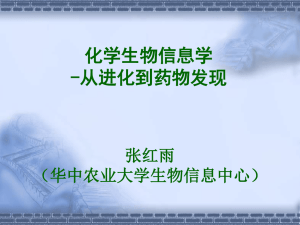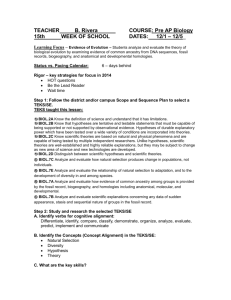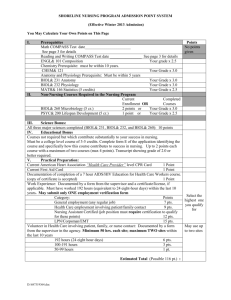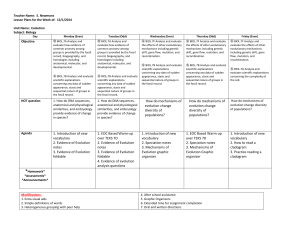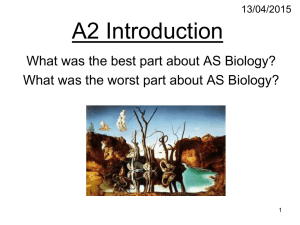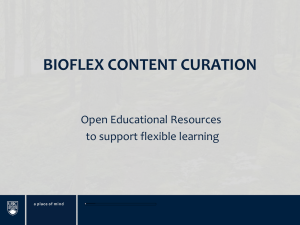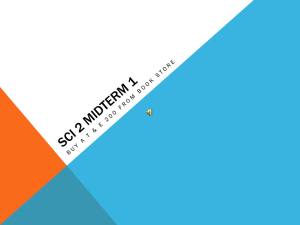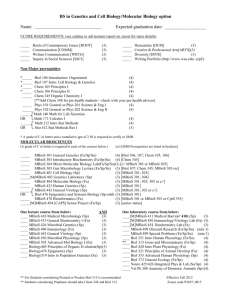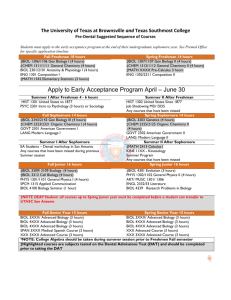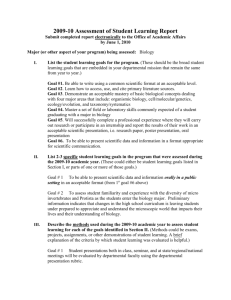TEACHER B. Rivera COURSE: Pre AP Biology 17th WEEK OF
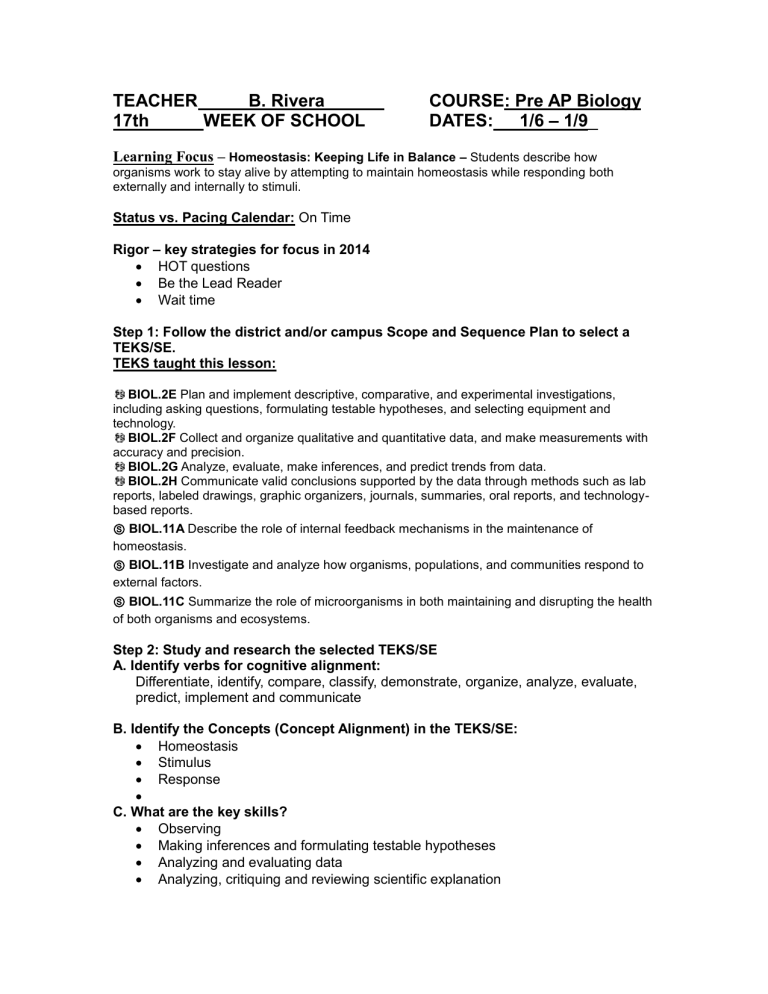
TEACHER B. Rivera
17th WEEK OF SCHOOL
COURSE: Pre AP Biology
DATES: 1/6 – 1/9
_
Learning Focus –
Homeostasis: Keeping Life in Balance – Students describe how organisms work to stay alive by attempting to maintain homeostasis while responding both externally and internally to stimuli.
Status vs. Pacing Calendar: On Time
Rigor – key strategies for focus in 2014
HOT questions
Be the Lead Reader
Wait time
Step 1: Follow the district and/or campus Scope and Sequence Plan to select a
TEKS/SE.
TEKS taught this lesson:
BIOL.2E Plan and implement descriptive, comparative, and experimental investigations, including asking questions, formulating testable hypotheses, and selecting equipment and technology.
BIOL.2F Collect and organize qualitative and quantitative data, and make measurements with accuracy and precision.
BIOL.2G
Analyze, evaluate, make inferences, and predict trends from data.
BIOL.2H Communicate valid conclusions supported by the data through methods such as lab reports, labeled drawings, graphic organizers, journals, summaries, oral reports, and technologybased reports.
Ⓢ BIOL.11A Describe the role of internal feedback mechanisms in the maintenance of homeostasis.
Ⓢ BIOL.11B Investigate and analyze how organisms, populations, and communities respond to external factors.
Ⓢ BIOL.11C Summarize the role of microorganisms in both maintaining and disrupting the health of both organisms and ecosystems.
Step 2: Study and research the selected TEKS/SE
A. Identify verbs for cognitive alignment:
Differentiate, identify, compare, classify, demonstrate, organize, analyze, evaluate, predict, implement and communicate
B. Identify the Concepts (Concept Alignment) in the TEKS/SE:
Homeostasis
Stimulus
Response
C. What are the key skills?
Observing
Making inferences and formulating testable hypotheses
Analyzing and evaluating data
Analyzing, critiquing and reviewing scientific explanation
D. What are the vocabulary Words in the TEKS/SE: a. Academic –
Organism
Population
Internal feedback mechanism
Community
Microorganism
Endotherm
Feedback inhibition
External stimulus
Ectotherm
Step 3: Using the results from above list the critical components of an aligned lesson in science.
What are the critical components of aligned lessons in teaching this TEKS/SE to the depth and complexity of STAAR/ EOC?
Organisms maintain homeostasis through internal feedback mechanisms in response to internal and external stimuli.
1. What internal feedback mechanisms do organisms have that help them maintain homeostasis in response to internal and external stimuli?
2. How do organisms maintain a relatively stable internal environment despite changes in their external environment?
3. Why are microorganisms essential to the health of organisms and ecosystems?
Step 4: Using the list of critical components from Step 3, go on a “Treasure Hunt” through programs, textbooks, and materials to find the most aligned lesson or lessons.
Monday 1/5 Teacher Work-Day
No Class
Tuesday 1/6
TEKS:
BIOL.2E
BIOL.2G
Ⓢ BIOL.11A
Wednesday
1/7
TEKS:
BIOL.2E
BIOL.2G
BIOL.2F
Ⓢ BIOL.11A
1. Objective: Students will examine key terms to describe feedback loops and how the process works.
2. Engage and connect
Anorexia: The disruption of homeostasis
3. Guided instruction – PowerPoint Presentation: Homeostasis
Independent practice –
In-class notes and participation
4. Check for understanding – Questions and Discussion
5. Homework ––
Define unit vocabulary words
1. Objective: Students will apply key terms used to describe negative feedback loops based on the analogy of a home heating system and use the model to construct a NFL that occurs within the body.
2. Engage and connect: How does a home heating system work?
3. Guided instruction – None
Independent practice – In groups, students will research how a home heating system works and attach key vocabulary words to description.
Thursday
1/8
TEKS:
BIOL.2E
BIOL.2G
BIOL.2F
Ⓢ BIOL.11A
Friday 1/9
TEKS:
BIOL.2E
BIOL.2G
BIOL.2F
Ⓢ BIOL.11A
Ⓢ BIOL.11B
4. Check for understanding – Questions and in-class discussion
5. Homework – Watch Bozeman Video: Positive and Negative Feedback Loops and complete worksheet
1. Objective: Students will get in groups and determine how the human body regulates homeostasis. (Using thermoregulation, blood pressure and O2/CO2 levels.)
2. Engage and connect: None
3. Guided instruction – None
Independent practice – Using a variety of resources, describe the process that occurs in your specific homeostatic mechanism.
4. Check for understanding – Class participation and questions.
5. Homework – Prepare for group presentation to be given tomorrow.
1. Objective: Students will become the human body and observe and identify key stages in the feedback loop
2. Engage and connect: None
3. Guided instruction – None
Independent practice – Class will read directions of objectives and working together, become the human body and explore the process glucose uptake.
4. Check for understanding – Questions, participation and peer discussions
5. Homework –
Watch Short Video: Contaminants in the Arctic Human Population
Watch Short Video: The Science Behind Appetite
Using what you have learned about feedback loops, write a detailed paper explaining how anorexia and disease are created and can cycle to continuously get worse.
Upon request by any special needs student, they can receive additional time to complete their assignments. Also, I am available to provide additional assistance to any student who requests it.
Depending on their specific request or my assessment of their involvement and understanding of the subject matter in the classroom, special needs students are given preferential seating.
Worksheets are used to prepare for each major test.
How will you assess learning and mastery?
Daily
Observations during student group and independent work time, lab work, and board work
Class participation and involvement in discussions and labs
Weekly
Homework
Labs, Focus Activities, and/or tests
Demonstrations or Labs:
Lab Activities – TBD

